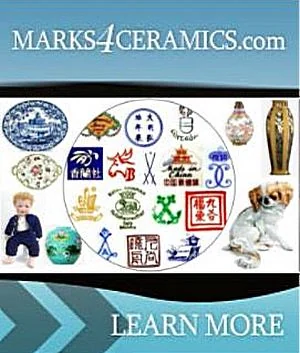Pricing Guides & Dictionary of Makers Marks for Antiques & Collectibles

A few examples of appraisal values for
SAMUEL YELLIN
Search our price guide for your own treasures
-
 Samuel Yellin T
Samuel Yellin T
Samuel Yellin T
Samuel Yellin T -
 SAMUEL YELLIN(American/Ukrainian,
SAMUEL YELLIN(American/Ukrainian, 1884-1940) Floral Sample Piece, stamped bottom right "Yellin", carved monel, 4 x 8-1/4 in. Condition: patina, scratching, surface accretion
SAMUEL YELLIN(American/Ukrainian,
SAMUEL YELLIN(American/Ukrainian, 1884-1940) Floral Sample Piece, stamped bottom right "Yellin", carved monel, 4 x 8-1/4 in. Condition: patina, scratching, surface accretion -
 SAMUEL YELLIN(American/Ukrainian,
SAMUEL YELLIN(American/Ukrainian, 1884-1940) Test Piece, stamped "Samuel Yellin", wrought iron, 7 x 12-1/4 in.; together with a photographic reproduction on paper, circa 1915, titled and dated verso, sight, 16 x 24 in.; placed between two pieces of plexiglass, 19 x 26 in. Condition: tarnish, warping, and surface accretion; laid on canvas, glue residue, separation between canvas and paper
SAMUEL YELLIN(American/Ukrainian,
SAMUEL YELLIN(American/Ukrainian, 1884-1940) Test Piece, stamped "Samuel Yellin", wrought iron, 7 x 12-1/4 in.; together with a photographic reproduction on paper, circa 1915, titled and dated verso, sight, 16 x 24 in.; placed between two pieces of plexiglass, 19 x 26 in. Condition: tarnish, warping, and surface accretion; laid on canvas, glue residue, separation between canvas and paper -
 Two Samuel Yellin Drawings one
Two Samuel Yellin Drawings one for poker with twisted shaft and ball end, drawing number two, marked "Samuel Yellin Metal Worker", and "For Mr. Leland Lyon", 46 x 9 in. (sight), mounted with clear corner clips, good condition, accompanied by handwritten note "A gift from George and Jill", (George Dixon); one titled "F.S.D. of wrought iron hardware for cabinets and drawers at north and south walls of sitting room, second floor, C.T. Pilling(?) r
Two Samuel Yellin Drawings one
Two Samuel Yellin Drawings one for poker with twisted shaft and ball end, drawing number two, marked "Samuel Yellin Metal Worker", and "For Mr. Leland Lyon", 46 x 9 in. (sight), mounted with clear corner clips, good condition, accompanied by handwritten note "A gift from George and Jill", (George Dixon); one titled "F.S.D. of wrought iron hardware for cabinets and drawers at north and south walls of sitting room, second floor, C.T. Pilling(?) r -
 FRAMED SAMUEL YELLIN
FRAMED SAMUEL YELLIN BLUEPRINT(Pennsylvania, 1885-1940) Design for a Gate, dated 12.29.1936, signed "Samuel Yellin Metal Worker Phila...", sight 14-1/2 x 9-3/4 in.; framed, 22 x 16-1/2 in. Provenance: Private Collection, Asheville, North Carolina Condition: small puncture/tear near angle/diagram, some staining to mat, not examined out of frame; frame with minimal wear
FRAMED SAMUEL YELLIN
FRAMED SAMUEL YELLIN BLUEPRINT(Pennsylvania, 1885-1940) Design for a Gate, dated 12.29.1936, signed "Samuel Yellin Metal Worker Phila...", sight 14-1/2 x 9-3/4 in.; framed, 22 x 16-1/2 in. Provenance: Private Collection, Asheville, North Carolina Condition: small puncture/tear near angle/diagram, some staining to mat, not examined out of frame; frame with minimal wear -
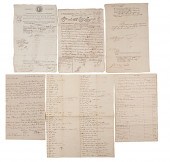 Samuel Lawrence Early New York
Samuel Lawrence Early New York Representative & the Lawrence Family Manuscript Archive An extensive archive of approximately 67 documents of the noted Lawrence family of New York spanning the years 1799 to 1908. Dealing primarily with Congressman Samuel Lawrence (1773-1837) but also concerning among other things the sea trade of Samuel??Ts uncle captain Andrew Lawrence from 1799 to 1801 on the brigs America Fair Columbian and Anna Elizabeth. The nautical items include the 1799 sworn testimony of Captain Andrew Lawrence of his witnessing the grounding of the ship Grand Turk in a nighttime gale on the reefs off Mango Key and his rescue of the captain and crew; entry papers for the brig America for the ports of Guadeloupe and Kingston Jamaica; several documents concerning the wine trade in Spain including a May 1800 contract with a Spanish wine merchant for a cargo of red wine (paying in silver reals); and an employment contract for a crew for the brig America??Ts voyage to Spain and back stopping in Madeira. Other sea-related items are a September 1813 letter to Samuel describing the American privateers Scourge and Rattlesnake preying on British shipping around Norway in the War of 1812 and a December 3 1822 issue of the National Intelligencer featuring a front page account of the USS Alligator single-handedly tackling a pirate squadron off the coast of Cuba and rescuing five captured American ships and their crews. Many letters in this archive revolve around the lengthy fight starting in 1816 between the Lawrences and the local government concerning the seizure of part of their land in Greenwich to lengthen 8th Avenue. These letters include hand-drawn plats of the area in question. Other letters from 1815 concern the scarcity of goods for the Lawrences??T businesses in upper New York state caused by the embargo in the War of 1812 but also the explosion in population of the area. Another interesting set of documents are the original contract including floor plans for the construction of the mansion known as the Lawrence Homestead and now known as the Fontainebleau Inn on Lake Cayuta in what was then Tioga County New York. Perhaps the most interesting business-related document is an 1824 award of $18 920.52 to Lawrence for a spoliation claim against the government of Spain under the terms of the Adam-Oniz Treaty. This may be from seizures of ships and/or cargoes during the war of 1812 since the Lawrences were involved in the Spanish wine trade. Several documents relate to the disposition of the estate of Jonathan Lawrence Samuel??Ts father. In addition to inventories of the estate there is an 1817 contract signed by the other heirs selling their partial claims to the slave Thomas Henry to Samuel signed and sealed by John Albert Joseph and William Lawrence. There is also a certified copy of the 1875 will of Samuel Richardson uncle to Samuel Lawrence??Ts son also named Samuel. State political items include the November 9 1816 appointment of Samuel as a Presidential elector for New York signed by Governor Daniel D. Tompkins; and a November 10 1820 letter from Richard Riker Recorder of New York City and a relative of Lawrence??Ts mother thanking Lawrence for ending the evils which have marked the Clinton administration (curious for the fact that in 1802 Riker was Clinton??Ts second in a duel stemming from the Hamilton/Burr duel). Documents from Lawrence??Ts career as Congressman include three printed dinner invitations from Secretary of State John Quincy Adams and his wife for balls in Washington DC given on January 8 18 and February 19 1824; a January 6 1824 letter from Lawrence to his wife from Washington DC on the difficulty in getting a Congressional caucus assembled to nominate a candidate for President (William H. Crawford would eventually get the nod for the contentious 1824 election); and a December 23 1823 ALS from John McLean as Postmaster General regarding the establishment of a new post office in Lawrence??Ts home district. A copy of the Statesman newspaper of New York City dated July 16 1824 contains a long article about the heated public disagreements between the President (Monroe) and his Secretary of State (John Q. Adams). There are several private letters from Samuel to his wife both from Albany as an Assemblyman of New York and as Congressman many with free franks. One letter warns his wife that their son has run away from his grandfather??Ts house due to being punished for habitual truancy and is on his way home. Other personal papers include a December 19 1835 New York City letter from Jonathan Lawrence to Samuel regarding the Great Fire of New York and the losses sustained by the family; and a large May 20 1858 passport document for Jonathan S. Lawrence to travel in the Empire of Austria signed by US consul in Trieste William A. Buffum. Dr G.H. Butler married the granddaughter of Samuel Lawrence Henrietta who was the last Lawrence blood relative to live in the mansion on Cayuta Lake. Butler papers include two 1869 letters of recommendation from Civil War commanders regarding his medical skill an 1886 ANS from Dublin Castle by John Bernard Burke of Burke??Ts Peerage and a manuscript treatment on the Arms of the Butler family also signed by Burke as Ulster King of Arms. Another genealogical document is a Lawrence family tree starting with an ancestor who was a Crusader at Acre in 1191 and ending at 1838. Associated items include two partial letters one apparently dated February 22 1603 and bearing the signature of Thomas Sackville Lord Buckhurst; and the other a partial document thought to date from around the same time and contain the names of early settlers of Nantucket including Thomas Coffin. There are three Albert Gallatin-related items: a printed 1806 policy letter to Congress regarding the public lands in the Indiana Territory a lithograph and an August 1802 ALS as Secretary of the Treasury with integrated free frank. Another curious piece is a recipe for the mass curing of hams (10 hams of about 6# each) annotated on reverse as being from Governor John Jay of New York! The last item is a blistering two-page letter written on election day in 1908 by William McKay excoriating the despotic rule of Theodore Roosevelt.
Samuel Lawrence Early New York
Samuel Lawrence Early New York Representative & the Lawrence Family Manuscript Archive An extensive archive of approximately 67 documents of the noted Lawrence family of New York spanning the years 1799 to 1908. Dealing primarily with Congressman Samuel Lawrence (1773-1837) but also concerning among other things the sea trade of Samuel??Ts uncle captain Andrew Lawrence from 1799 to 1801 on the brigs America Fair Columbian and Anna Elizabeth. The nautical items include the 1799 sworn testimony of Captain Andrew Lawrence of his witnessing the grounding of the ship Grand Turk in a nighttime gale on the reefs off Mango Key and his rescue of the captain and crew; entry papers for the brig America for the ports of Guadeloupe and Kingston Jamaica; several documents concerning the wine trade in Spain including a May 1800 contract with a Spanish wine merchant for a cargo of red wine (paying in silver reals); and an employment contract for a crew for the brig America??Ts voyage to Spain and back stopping in Madeira. Other sea-related items are a September 1813 letter to Samuel describing the American privateers Scourge and Rattlesnake preying on British shipping around Norway in the War of 1812 and a December 3 1822 issue of the National Intelligencer featuring a front page account of the USS Alligator single-handedly tackling a pirate squadron off the coast of Cuba and rescuing five captured American ships and their crews. Many letters in this archive revolve around the lengthy fight starting in 1816 between the Lawrences and the local government concerning the seizure of part of their land in Greenwich to lengthen 8th Avenue. These letters include hand-drawn plats of the area in question. Other letters from 1815 concern the scarcity of goods for the Lawrences??T businesses in upper New York state caused by the embargo in the War of 1812 but also the explosion in population of the area. Another interesting set of documents are the original contract including floor plans for the construction of the mansion known as the Lawrence Homestead and now known as the Fontainebleau Inn on Lake Cayuta in what was then Tioga County New York. Perhaps the most interesting business-related document is an 1824 award of $18 920.52 to Lawrence for a spoliation claim against the government of Spain under the terms of the Adam-Oniz Treaty. This may be from seizures of ships and/or cargoes during the war of 1812 since the Lawrences were involved in the Spanish wine trade. Several documents relate to the disposition of the estate of Jonathan Lawrence Samuel??Ts father. In addition to inventories of the estate there is an 1817 contract signed by the other heirs selling their partial claims to the slave Thomas Henry to Samuel signed and sealed by John Albert Joseph and William Lawrence. There is also a certified copy of the 1875 will of Samuel Richardson uncle to Samuel Lawrence??Ts son also named Samuel. State political items include the November 9 1816 appointment of Samuel as a Presidential elector for New York signed by Governor Daniel D. Tompkins; and a November 10 1820 letter from Richard Riker Recorder of New York City and a relative of Lawrence??Ts mother thanking Lawrence for ending the evils which have marked the Clinton administration (curious for the fact that in 1802 Riker was Clinton??Ts second in a duel stemming from the Hamilton/Burr duel). Documents from Lawrence??Ts career as Congressman include three printed dinner invitations from Secretary of State John Quincy Adams and his wife for balls in Washington DC given on January 8 18 and February 19 1824; a January 6 1824 letter from Lawrence to his wife from Washington DC on the difficulty in getting a Congressional caucus assembled to nominate a candidate for President (William H. Crawford would eventually get the nod for the contentious 1824 election); and a December 23 1823 ALS from John McLean as Postmaster General regarding the establishment of a new post office in Lawrence??Ts home district. A copy of the Statesman newspaper of New York City dated July 16 1824 contains a long article about the heated public disagreements between the President (Monroe) and his Secretary of State (John Q. Adams). There are several private letters from Samuel to his wife both from Albany as an Assemblyman of New York and as Congressman many with free franks. One letter warns his wife that their son has run away from his grandfather??Ts house due to being punished for habitual truancy and is on his way home. Other personal papers include a December 19 1835 New York City letter from Jonathan Lawrence to Samuel regarding the Great Fire of New York and the losses sustained by the family; and a large May 20 1858 passport document for Jonathan S. Lawrence to travel in the Empire of Austria signed by US consul in Trieste William A. Buffum. Dr G.H. Butler married the granddaughter of Samuel Lawrence Henrietta who was the last Lawrence blood relative to live in the mansion on Cayuta Lake. Butler papers include two 1869 letters of recommendation from Civil War commanders regarding his medical skill an 1886 ANS from Dublin Castle by John Bernard Burke of Burke??Ts Peerage and a manuscript treatment on the Arms of the Butler family also signed by Burke as Ulster King of Arms. Another genealogical document is a Lawrence family tree starting with an ancestor who was a Crusader at Acre in 1191 and ending at 1838. Associated items include two partial letters one apparently dated February 22 1603 and bearing the signature of Thomas Sackville Lord Buckhurst; and the other a partial document thought to date from around the same time and contain the names of early settlers of Nantucket including Thomas Coffin. There are three Albert Gallatin-related items: a printed 1806 policy letter to Congress regarding the public lands in the Indiana Territory a lithograph and an August 1802 ALS as Secretary of the Treasury with integrated free frank. Another curious piece is a recipe for the mass curing of hams (10 hams of about 6# each) annotated on reverse as being from Governor John Jay of New York! The last item is a blistering two-page letter written on election day in 1908 by William McKay excoriating the despotic rule of Theodore Roosevelt. -
 Samuel Haydon Sexton (New York,
Samuel Haydon Sexton (New York, 1813-1890) Portrait of a Family, circa 1838, in a graveside garden, unsigned, oil on panel, 26-7/8 x 23-1/8 in.; gilt wood and composition frame,
Samuel Haydon Sexton (New York,
Samuel Haydon Sexton (New York, 1813-1890) Portrait of a Family, circa 1838, in a graveside garden, unsigned, oil on panel, 26-7/8 x 23-1/8 in.; gilt wood and composition frame, -
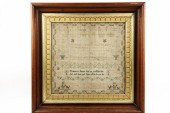 SAMPLER - Student Work on Linen
SAMPLER - Student Work on Linen by Elizabeth Yerman Heath 'Tenth Year of Her Age and the Year of Our Lord 1803 December 28' with vine border birds potted trees and flowers cats and dogs lion and crowns six line blessing and two line rhyme in vint
SAMPLER - Student Work on Linen
SAMPLER - Student Work on Linen by Elizabeth Yerman Heath 'Tenth Year of Her Age and the Year of Our Lord 1803 December 28' with vine border birds potted trees and flowers cats and dogs lion and crowns six line blessing and two line rhyme in vint -
 SAMUEL COLEMAN (COLMAN)
SAMUEL COLEMAN (COLMAN) (AMERICAN, 1832-1920) NORTH CONWAY, 1858 OIL ON CANVAS LAID ON BOARD: 4 1/2 X 7 1/2 IN.SAMUEL COLEMAN (COLMAN), (AMERICAN, 1832-1920) NORTH CONWAY, 1858, Oil on canvas laid on board: 4 1/2 x 7 1/2 in. Framed; verso inscribed: North Conway/ Samuel Coleman/ 1858
SAMUEL COLEMAN (COLMAN)
SAMUEL COLEMAN (COLMAN) (AMERICAN, 1832-1920) NORTH CONWAY, 1858 OIL ON CANVAS LAID ON BOARD: 4 1/2 X 7 1/2 IN.SAMUEL COLEMAN (COLMAN), (AMERICAN, 1832-1920) NORTH CONWAY, 1858, Oil on canvas laid on board: 4 1/2 x 7 1/2 in. Framed; verso inscribed: North Conway/ Samuel Coleman/ 1858 -
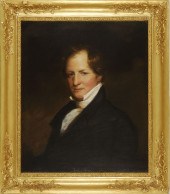 ATTRIBUTED TO THOMAS
ATTRIBUTED TO THOMAS SULLYAmerican 1783-1872Portrait of Dr. Samuel Johnston Cramer (1779-1840) great-grandfather of Elizabeth M. Lobingier. Attribution determined by W.G. Constable Curator of Paintings Boston Museum of Fine Arts. Portrait and frame restored at the Robert Vose Galleries Boston May 10 1941.Oil on panel 28 x 24''. Framed.''
ATTRIBUTED TO THOMAS
ATTRIBUTED TO THOMAS SULLYAmerican 1783-1872Portrait of Dr. Samuel Johnston Cramer (1779-1840) great-grandfather of Elizabeth M. Lobingier. Attribution determined by W.G. Constable Curator of Paintings Boston Museum of Fine Arts. Portrait and frame restored at the Robert Vose Galleries Boston May 10 1941.Oil on panel 28 x 24''. Framed.'' -
 (JOHNSON SAMUEL) The Yale Edition
(JOHNSON SAMUEL) The Yale Edition of the Works of Samuel Johnson. New Haven and London: Yale University Press 1986. 16 vols. 8vo publisher's blue cloth lettered in gilt six with dust jackets. Light wear to boards and dust jackets; otherwise fine.
(JOHNSON SAMUEL) The Yale Edition
(JOHNSON SAMUEL) The Yale Edition of the Works of Samuel Johnson. New Haven and London: Yale University Press 1986. 16 vols. 8vo publisher's blue cloth lettered in gilt six with dust jackets. Light wear to boards and dust jackets; otherwise fine. -
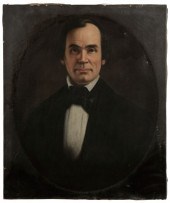 Samuel Shaver (Tennessee,
Samuel Shaver (Tennessee, 1816-1878), Andrew Johnson, oil on canvas, circa 1856, prior to the presidency, unsigned, 30 x 25 in., original 19th century gilt wood frame,
Samuel Shaver (Tennessee,
Samuel Shaver (Tennessee, 1816-1878), Andrew Johnson, oil on canvas, circa 1856, prior to the presidency, unsigned, 30 x 25 in., original 19th century gilt wood frame, -
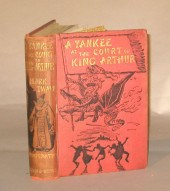 1 vol. (Clemens, Samuel L.) A
1 vol. (Clemens, Samuel L.) A Yankee at The Court of King Arthur by Mark Twain [A Connecticut Yankee in King Arthur's Court]. London: Chatto & Windus, 1889. First English edition. 8vo, orig. gilt-lettered black-stamped pictorial red cloth; light to moderate edge wear, spine ends frayed, front joint occasionally frayed, hinges slightly stressed. In red cloth fall-down box. Frontis., full-page & text illus. by Dan Beard. With 32 pp. pub. cat. dated October, 1889. Scattered light foxing. BAL
1 vol. (Clemens, Samuel L.) A
1 vol. (Clemens, Samuel L.) A Yankee at The Court of King Arthur by Mark Twain [A Connecticut Yankee in King Arthur's Court]. London: Chatto & Windus, 1889. First English edition. 8vo, orig. gilt-lettered black-stamped pictorial red cloth; light to moderate edge wear, spine ends frayed, front joint occasionally frayed, hinges slightly stressed. In red cloth fall-down box. Frontis., full-page & text illus. by Dan Beard. With 32 pp. pub. cat. dated October, 1889. Scattered light foxing. BAL -
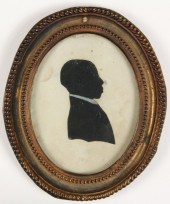 SILHOUETTE- circa 1790 of an
SILHOUETTE- circa 1790 of an African American Gentleman said to depict one of the most prominent Black religious leaders of the Eighteenth Century Reverend Richard Allen. In a metal frame of the period. H. 4 3/4'' x W. 4''. From the Marvin Sadik Collect
SILHOUETTE- circa 1790 of an
SILHOUETTE- circa 1790 of an African American Gentleman said to depict one of the most prominent Black religious leaders of the Eighteenth Century Reverend Richard Allen. In a metal frame of the period. H. 4 3/4'' x W. 4''. From the Marvin Sadik Collect -
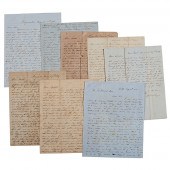 Letters Between the Sturges
Letters Between the Sturges Brothers Most Antebellum Including J.R. Sturges 3rd GA Infantry KIA These 58 letters encompass a "snapshot" of antebellum life in the South.Samuel Sturges (1774-1831) was born in Fairfield Co. CT. He arrived in Georgia shortly after the Revolutionary war although the exact date is uncertain. They were in Georgia by 1801 and in Waynesborough (now Waynesboro) by 1804. In May of 1804 he married Rachel Lowery (1786-1837). Samuel became one of the leaders of the community one of five members of the Board of Town Incorporators and was elected in 1813 as one of the first five commissioners. He held other town positions through his lifetime there.Samuel and Rachel had three children: Jane Robinson (1809-1817) William Urquhart (1816-1884) and John Reynolds (1827-1862). In the 1830 Census Samuel lists 10 slaves. William seems to have spent most of his career as a hotel keeper although he occasionally became something of a merchant picking up items for townspeople when he or his agents went to New York for supplies. Samuel died in 1831 when his youngest son was only three. Rachel followed but six years later.About this time the U.S. government was moving native peoples off their lands and the Cherokee had prime farm land in Georgia. The tribe appealed to the Supreme Court and won but President Andrew Jackson had the U.S. Army move them off their land anyway in what would be known as the "Trail of Tears". The Cherokee Land Lottery of 1832 indicates that the orphans of Samuel Sturges received lottery number 115 for the 8th District 1st section and Rachel (Rachael) received 143 for the 6th District 3rd Section. William would have been an adult at the time of Rachel's death so presumably he continued raising his younger brother John and the brothers remained close for life. William appears in the mid-century censuses as a hotel keeper but may have been a merchant earlier (implied in some of his letters).By 1844 John had made his way "up east." In the first letter in the collection William writes to John [4 Sept. 1844] in Princeton NJ passing along brotherly advice particularly about health issues: I am glad you took the step you did by entering on your studies soon after your arrival and congratulate yourself & John Shewmaker upon your success in entering the Sophomore class. I trust neither of you will flag yet I would advise that you keep an eye on your health. In that climate the constitution is easily undermined by leading too sedentary a life. Provide yourself with some means of bodily exercise perform some daily labour or take pedestrian exercise. Exercise with the "dumb bells" will tend to expand the chest and develop the muscles of the arms. These may seem of no importance now and may make seemingly no very great improvement in your feelings while you continue the use. They may be used as preventions. He also suggests that the young men enlist an agent to cash checks sent up to them and to hold any monies which were not immediately needed.On occasion William discusses politics in his letters. November of 1844 is one of those occasions being a presidential election year. (reconstructed letters in brackets.) The news political of this State is that sh[e] has cast her vote for Mr. Polk for president. The lat[e] [re]turns indicate that Mr. Polk will be our next President Much [to] the surprise of all politicians. I must feel as an American citizen should feel no little mortification at the result of this [con]test. I do heartily rejoice however that it is over. We have been from one end of this union to the other in a perfect stew and as the Whig "Pot" has boiled over and spilt all the fat in the fire (excuse this sentence) & we cannot make amends I trust we will have a little quiet & a little more trade and I truly hope a good deal more good feeling from our neighbors to another. The people will now return to their uniform Christian feelings. He goes on to note that the local medical college has resumed with an overflow class of 125 students and describes the amusements in town - the theater circus a ventriloquist / magician.William seems to have gone "all out" into Whig politics. The party formed largely in opposition to Jacksonian policies. It advocated investment in roads and railroads to tie the country together economically. Henry Clay one of the better known leaders of the party advocated returning proceeds from the sale of public lands to the states to make these improvements. This would certainly have been an attractive position for these members of the "merchant class " increasing the availability and decreasing the price of goods. At one point William writes referring to the folks in Burke and Waynesboro: Those people are to be envied somewhat for their quiet (seeming) happiness. But truly is a life of that kind to be objected to because of the excess of doing naught that tends to the usefulness or benefits of the human family. They have no meetings or gatherings but for frivolous amusement. He goes on to say that Augusta is determined to turn itself into a manufacturing town but so far "all talk no action." [30 Jan. 1845] In October 1845 William notes that Georgia elected a Whig governor [George Crawford] and would likely elect a Whig senator.Other Whig party leaders included William Henry Harrison and Daniel Webster. After Harrison's death John Tyler became president and his stand on states' rights was even stronger than most particularly attractive to the South as abolition issues were heating up. In 1847 Webster made a trip to this small southern town which William describes in his letter of 29 May: The very distinguished Mr. Webster of Massachusetts has been among us for some time near a week. He being detained on a/c [account] of health. He received from men of all parties the most marked attention and I hope will return well impressed with Southern hospitality and the better understanding our institutions particularly that of slavery. He says he will go home and tell his people what pleasure he derived from this time. He spent one day and night in Waynesboro when all the village visited him except Mr. Douglass.William seems to be a bit mistrusting of politicians generally. In a postscript to his letter of 20 Feby. 1845: A Duel which took place on the morning of the 20th (yesterday) terminated in the death of one of the combatants. They were double Brothers-in-Law and citizens of So. Ca. They fought at a distance of ten paces with muskets. From report there is another hostile party making preliminaries now in the city. They are to fire at 10 feet distant with pistols. This party are men who have been in high confidence in State Offices. It does not speak well of their morals without which no man can be safely trusted or truly great.By late in 1845 John and his friend decided that they did not really like Princeton although specific reasons are not indicated. They seem to have decided on Yale. In December 1845 William advises his brother: After conversation with John T. Shoemaker who had just reached here I have reconsidered your proposition to leave Princeton and now give my consent that you do so if you wish; the only advice I can give you is that you make the best possible use of your time while in any college.. I hope you will get into as few quarrels with the abolitionists in and about New Haven as possible for you must know that this is the hotbed of abolitionism and constant subject for conversation even among the old maids of which that place abounds in confused numbers. And abolition isn't the only issue to be considered [6 Jan. 1846]: I cannot know myself how or why either of the institutions may be the better for your education and would have preferred your graduating at Princeton only because it is know[n] as a "Southern institution "[emph. added] and I had presumed that you were as pleasantly located there as at any place except home.There was also a family connection to the area and it appears that John was curious about the family history and that may have attracted him to New Haven. William writes [18 Jany. 1846]: I am unable to give you as yet any clue to any members of our family. As to our Fathers family I can only say that within the state of Connecticut there must still some reside and very probably many near New Haven. Our Father was I think a native of Fairfield and presume that there was none of his immediate progenitors (?) living at or about the time of his death. I know only of one Brother to him and he died in this place now many years since.. [Nathaniel Sturges Sr. died in Waynesboro 7 Nov. 1826] We have no relations in the north but upon the Father's side and our Mothers being now nearly extinct.. However a number of times William emphasizes that John's education is more dependent on his efforts than on the school he chooses [4 Jany. 1846]: I have no objections to the change [of schools] and leave it entirely to your own discretion to stop at either of the institutions. .There is I think little depending on the institution you may pursue your collegiate course in or at least much less than upon your own industry and pursuit after knowledge. [18 Jany. 1846] I cannot deem it necessary or even prudent to lay out any path for your future course through life.. I desire you if it suits you to study Law. He is for any education that can be obtained - for anyone. It appeared that John's friend John Shewmaker could no longer afford to live in the East and continue in college. [8 Nov. 1845] If I were John I would exact the sum sufficient from my guardian to take me [through the] course - It might infringe a little upon my estate but the "value recd." would doubly compensate for the expenditure so made.William makes another interesting recommendation to his brother. [18 Jany. 1846] I will propose one thing which in after I think you will not repent(?) of following and this is that you look about when you return home for a good wife with a comfortable little fortune not however for her fortune alone. Earlier he warned of marrying in haste. He notes that there are six weddings in the next few weeks and hopes those who "act in haste" may not have cause "to repent at leisure" [8 Nov. 1845]. He also relates the story of a friend Nancy W. who became engaged to a gentleman she knew only a short time [20 Octr. 1845]. Her guardian persuaded her to wait a bit to marry. Two days later the man was engaged to her sister according to William proving the adage "one of the name was as good as the same." William does however suggest the man would have made a good husband. He had been twice widowed and had 3 children including an infant of only three months probably explaining his "rush to the altar."Along with the "states' rights" issues of the Whig party abolition was rearing its head as William's comment about New Haven indicates: A rumour is at present being circulated from Burke that Saml. Russell has run off with some several Negroes the property of different person near Waynesboro. Sam has very mysteriously disappeared from Burke and since the Christmas Holiday the negroes have not been heard of and further proof of his guilt by the testimony of a gentleman returning from the ??? part of this state that he saw him on board of some Steam Boat bound westward. The supposition is that he has [illeg.] his course for Texas via New Orleans and steps have been taken to follow him. We can only hope that justice may reach the offenders of the Law so speedily as to be to others a good warning . A letter from his niece Abby indicates the general attitude of this family toward "the help." She went to Savannah for a visit and [11 Feb. 1846]: On my way home I stopped at Waynesboro for three or four hours. While there I went round to see Cousin Betsy Douglas whom I found quite well. .I saw all the servants they were all quite well and want to see you very much indeed. Whenever they see me the first question is when did you hear from Mas. John and how is he. You know they are all to be sold next month. Uncle William is going to try and buy them all in as he hates to have them separated. Old Aunt Beckey hated it very much she can scarcely speak of it without tears coming into her eyes. A letter from William a month or so later indicates that he did just that. [9 March 1846] I remained in the village [Waynesboro] until after the sale which resulted in my purchasing all the negroes except little Becky who Mr. Dowse bot [bought] for Abby & Mary Ann and her daughters who was bot by Sid Dowse as was previously agreed upon. The servants are all now well satisfied and hope not to be harassed by the fear of being sold again soon. For the present they will all remain in Waynesboro but I presume soon to find a good situation for Lizzy here. Eliza will remain with Dr. Mst. and Celia will remain as a kind of nurse to Old Aunt Becky. In nearly every letter the servants send their regards and William reports their health status as well as that of the family.Health was a major concern especially in Georgia summers. The end of May brought the end of the school term and the end of the social season especially as that segment of the population would generally leave for the worst of the summer. In May 1845 William wrote: I . commend your contemplated tour on foot. I cannot advise however to make the tour if you must expose yourself to the sun through the month of July. Having been shut up in coledge [sic] regulation for many months previous I should think you are but ill prepared to much exposure to the sun and the consequent fatigue of such an undertaking. . I would advise.a trip as a manner of recreating the mind and seeing something of the many places of renown of which our glorious land abounds. He notes there was a party for a newly married couple This party winds up the gayiety of the village at least for this season. Many of those who move from Burke left the same week for their summer residences and the village is now left with its usual number of "Summer inhabitants " and entirely rid of its young folks. .I am sorry to say that old Aunt Becky's health is fast declining though she yet continues to go about. The rest of our servants are all well. Apparently William followed other residents of Burke County and went to Madison Springs: I am at quite a delightfull place being one of the fashionable resorts for the gay and fashionable of this State & SoCa. I have been drinking freely of the medicinal water here and find from it a great benefit induced thus far. I feel my strength much recovered & can see a decided improvement in fullness of person. After a period he writes John again apologizing that he has not written sooner but he did not want to be thought unsociable. [8 Sept. 1845] I have recovered in a very considerable degree the strength that a debility of two summers had rid me of. I consider the water here efficacious & the air fine and bracing but the constant exercise the spirits are compelled to take in part with the company goes a greater ways in the restoration of many visitors than anything else. .I think I have come in for my share of the good benefits of very agreeable society and do offer up my thanks for the advantage enjoyed. Indicates (at end of the letter) that it has been a dry year: So far as I can learn the health of that part of Georgia considered sickly in summer is better than I've known and the people have nothing to complain of but the shortness of the crop. They will make a sufficiency of provisions and a ? crop of cotton. This will for those who are out of debt but those - and they are many - who presumed to pay old debts from the proceeds of this crop must be disappointed. In the counties of the state from this to the Tennessee line the crop of provisions promises to be so short that many have made arrangement to leave the country and seek some place where corn is plenty. There has been quite a flood of emigrants from Carolina to Tennessee in search of cheap provisions. I am glad to know that they will find it quite low there. Considerable distress must be experienced among the poor of some sections as they have neither provisions or the means to buy them. Yet we feel assured that there will be no starving as the sympathies of the more independent class will move them to the relief of the needy. Even into October he notes the relative health of the area during the summer but with the dry weather comes "insufferable heat."As winter came around however he recommended to John that he find a doctor up in New Haven: I would advise that you get a good Medical person to vaccinate you as the Small Pox seems to be traveling the "country all over" - and you are by necessity associated with persons from every part of the land. Of course smallpox vaccinations were used even by George Washington during the Revolutionary War and William understood exposure risk to the disease in those urban population centers. Less clear seems to be their understanding of other "tropical diseases." In 1848 [3 July] he writes to Johns that there is much sickness in Augusta. Germans were working on a canal living in filthy conditions and the doctor was reporting cases of yellow fever. We now know that neither "Germans" nor "filthy conditions" (per se) would have been responsible for this outbreak - but more likely the canal itself since this would have been an excellent breeding ground for the mosquitoes that carry this disease (although that knowledge did not come until construction of the Panama Canal though suspected somewhat earlier).Besides politics slavery and other moral issues late in John's college career William addresses the other "third rail." You must excuse me my dear Brother that I have never mentioned the subject of Religion when writing to you. . That I know a just part is for us to perform which upon this earth and that we will have to account for all the deeds done in the body to a just God is sufficient to warn me always to a proper course through life. He goes on to say that he has not joined a church because he finds many of the "code of laws governing them" impossible for mere mortals to follow and many of them are "petty and unnecessary." However a couple years earlier when niece Abby joined the Presbyterian church William commented [28 April 1845] I consider the garb of Religion gives peculiar beauty to the female (young particularly) character.Another view of the Southern social scene comes from Abby's letters. Abby married 20 May 1846 and several letters from William deal with John's preparations to return home for both the wedding and summer break. In the autumn Abby writes that she and her new husband left Bath shortly after John did (presumably to return to school) and they went to the seaboard then on to Mr. Jones' family home. Although worried about how she would be received by his family she was received warmly as a member of the family. She tells her cousin [30 Sept. 1846]: ...for nothing is more pleasant than to be beloved particularly in the circle in which we are to move and I sincerely trust that hereafter my actions will not be such as to forfeit the confidence and esteem of these kind friends.You can readily perceive my dear Uncle that my situation at first upon arriving at the home of my husband was peculiarly delicate and embarrassing. A few weeks had wrought a strange and sudden revolution in my existence. A young girl surrounded by her family circle engrossed with maidenly occupation and concerned only with the passing events of the home was transformed into the wife the home of her childhood forsaken and a new train of duties attendant upon this change opened to her view. This responsibility for a time was felt very acutely but the cordial reception of which I have spoken of before in a short time banished these feelings and I felt not only reconciled to but delighted with my future prospects. Every member of the family welcomed me to their midst and I already feel identified with them in every particular. Later she adds: I have been busily employed preparing for housekeeping which I hope to commence about the last of November. I look forward to the time with a great deal of pleasure and yet with fear to [sic] for I have so little experience in the mysteries of housekeeping. I dare say I will do many things that is wrong yet all had to learn by experience .I suppose that I will have to do the same. She then suggests that she will have William or someone pick up items for her that are cheaper in the North than at home another reality of Southern life even antebellum.John graduated from Yale in 1847 but seems to have remained in the north for a bit. There is one letter from William addressed to John in New Haven with a postal stamp for July 1848. William for his part married Georgia Ann Ward (1826 - 1905) on 10 Aug. By 1850 John had returned to Georgia where the 1850 census shows him as a 22-year-old schoolteacher living with William plus just over a dozen single men two couples and a widow with two daughters in the hotel/boarding house. John seems to have also been studying law in Augusta at the same time. In 1852 John became County Surveyor for Burke County and there are about 20 letters from the 1850s relating to this role. One of the early ones is to another surveyor asking what they charge for surveying etc. apparently trying to determine his rates in this new occupation. Another letter relates to measurements of the variation in magnetic deviation from true north. A few of the requests become rather insistent: I am getting in a hurry about that surveying and I wish you to come over tonight - so that you can make an early start as I wish you to do some surveying in different places.Most of the letters contain requests for surveys or documents from earlier surveys but one contains political opinions along with a request for paperwork on a property. Sam P. Davis [9 July 1852] suggests that political excitement is waning and only a 3rd candidate is likely to get people interested again. He notes that if the election is only between the present candidates he would vote for Pierce since "Pierce can show a clean hand on the n---er question [his underline]. This is more than can be said of Scott." The question of slavery was foremost in the minds of local "movers and shakers." Scott had come out as anti-slavery (a problem for southern voters) in spite of the Whig pro-slavery platform (a problem for northern voters). Daniel Webster rejected by his Whig party as their candidate ran as a Union Party (basically Southern Whigs) candidate and despite the fact that he died before the election still received several thousand Georgia votes!In 1860 John was still living in William's hotel/boarding house along with 15 men many of whom were also law students or lawyers and an older woman and her adult son. He never seems to have found his "good wife with a comfortable little fortune" suggested by brother William but he did seem to be building his own home. After the November election South Carolina seceded and several other states called their own conventions. Georgia's election of delegates to the convention that would determine her course occurred on the second day of the new year. These delegates then convened in Milledgeville on the 16th to begin debating the issue. By the 19th George Crawford convention president and former Whig governor declared Georgia officially seceded from the United States. Within two more weeks the infant Confederate States of America formed and two months later the offspring nation was at war with her northern parent. The last six letters are war da Condition: Variable as expected. Only one with insect/rodent damage extensive enough for loss of text.
Letters Between the Sturges
Letters Between the Sturges Brothers Most Antebellum Including J.R. Sturges 3rd GA Infantry KIA These 58 letters encompass a "snapshot" of antebellum life in the South.Samuel Sturges (1774-1831) was born in Fairfield Co. CT. He arrived in Georgia shortly after the Revolutionary war although the exact date is uncertain. They were in Georgia by 1801 and in Waynesborough (now Waynesboro) by 1804. In May of 1804 he married Rachel Lowery (1786-1837). Samuel became one of the leaders of the community one of five members of the Board of Town Incorporators and was elected in 1813 as one of the first five commissioners. He held other town positions through his lifetime there.Samuel and Rachel had three children: Jane Robinson (1809-1817) William Urquhart (1816-1884) and John Reynolds (1827-1862). In the 1830 Census Samuel lists 10 slaves. William seems to have spent most of his career as a hotel keeper although he occasionally became something of a merchant picking up items for townspeople when he or his agents went to New York for supplies. Samuel died in 1831 when his youngest son was only three. Rachel followed but six years later.About this time the U.S. government was moving native peoples off their lands and the Cherokee had prime farm land in Georgia. The tribe appealed to the Supreme Court and won but President Andrew Jackson had the U.S. Army move them off their land anyway in what would be known as the "Trail of Tears". The Cherokee Land Lottery of 1832 indicates that the orphans of Samuel Sturges received lottery number 115 for the 8th District 1st section and Rachel (Rachael) received 143 for the 6th District 3rd Section. William would have been an adult at the time of Rachel's death so presumably he continued raising his younger brother John and the brothers remained close for life. William appears in the mid-century censuses as a hotel keeper but may have been a merchant earlier (implied in some of his letters).By 1844 John had made his way "up east." In the first letter in the collection William writes to John [4 Sept. 1844] in Princeton NJ passing along brotherly advice particularly about health issues: I am glad you took the step you did by entering on your studies soon after your arrival and congratulate yourself & John Shewmaker upon your success in entering the Sophomore class. I trust neither of you will flag yet I would advise that you keep an eye on your health. In that climate the constitution is easily undermined by leading too sedentary a life. Provide yourself with some means of bodily exercise perform some daily labour or take pedestrian exercise. Exercise with the "dumb bells" will tend to expand the chest and develop the muscles of the arms. These may seem of no importance now and may make seemingly no very great improvement in your feelings while you continue the use. They may be used as preventions. He also suggests that the young men enlist an agent to cash checks sent up to them and to hold any monies which were not immediately needed.On occasion William discusses politics in his letters. November of 1844 is one of those occasions being a presidential election year. (reconstructed letters in brackets.) The news political of this State is that sh[e] has cast her vote for Mr. Polk for president. The lat[e] [re]turns indicate that Mr. Polk will be our next President Much [to] the surprise of all politicians. I must feel as an American citizen should feel no little mortification at the result of this [con]test. I do heartily rejoice however that it is over. We have been from one end of this union to the other in a perfect stew and as the Whig "Pot" has boiled over and spilt all the fat in the fire (excuse this sentence) & we cannot make amends I trust we will have a little quiet & a little more trade and I truly hope a good deal more good feeling from our neighbors to another. The people will now return to their uniform Christian feelings. He goes on to note that the local medical college has resumed with an overflow class of 125 students and describes the amusements in town - the theater circus a ventriloquist / magician.William seems to have gone "all out" into Whig politics. The party formed largely in opposition to Jacksonian policies. It advocated investment in roads and railroads to tie the country together economically. Henry Clay one of the better known leaders of the party advocated returning proceeds from the sale of public lands to the states to make these improvements. This would certainly have been an attractive position for these members of the "merchant class " increasing the availability and decreasing the price of goods. At one point William writes referring to the folks in Burke and Waynesboro: Those people are to be envied somewhat for their quiet (seeming) happiness. But truly is a life of that kind to be objected to because of the excess of doing naught that tends to the usefulness or benefits of the human family. They have no meetings or gatherings but for frivolous amusement. He goes on to say that Augusta is determined to turn itself into a manufacturing town but so far "all talk no action." [30 Jan. 1845] In October 1845 William notes that Georgia elected a Whig governor [George Crawford] and would likely elect a Whig senator.Other Whig party leaders included William Henry Harrison and Daniel Webster. After Harrison's death John Tyler became president and his stand on states' rights was even stronger than most particularly attractive to the South as abolition issues were heating up. In 1847 Webster made a trip to this small southern town which William describes in his letter of 29 May: The very distinguished Mr. Webster of Massachusetts has been among us for some time near a week. He being detained on a/c [account] of health. He received from men of all parties the most marked attention and I hope will return well impressed with Southern hospitality and the better understanding our institutions particularly that of slavery. He says he will go home and tell his people what pleasure he derived from this time. He spent one day and night in Waynesboro when all the village visited him except Mr. Douglass.William seems to be a bit mistrusting of politicians generally. In a postscript to his letter of 20 Feby. 1845: A Duel which took place on the morning of the 20th (yesterday) terminated in the death of one of the combatants. They were double Brothers-in-Law and citizens of So. Ca. They fought at a distance of ten paces with muskets. From report there is another hostile party making preliminaries now in the city. They are to fire at 10 feet distant with pistols. This party are men who have been in high confidence in State Offices. It does not speak well of their morals without which no man can be safely trusted or truly great.By late in 1845 John and his friend decided that they did not really like Princeton although specific reasons are not indicated. They seem to have decided on Yale. In December 1845 William advises his brother: After conversation with John T. Shoemaker who had just reached here I have reconsidered your proposition to leave Princeton and now give my consent that you do so if you wish; the only advice I can give you is that you make the best possible use of your time while in any college.. I hope you will get into as few quarrels with the abolitionists in and about New Haven as possible for you must know that this is the hotbed of abolitionism and constant subject for conversation even among the old maids of which that place abounds in confused numbers. And abolition isn't the only issue to be considered [6 Jan. 1846]: I cannot know myself how or why either of the institutions may be the better for your education and would have preferred your graduating at Princeton only because it is know[n] as a "Southern institution "[emph. added] and I had presumed that you were as pleasantly located there as at any place except home.There was also a family connection to the area and it appears that John was curious about the family history and that may have attracted him to New Haven. William writes [18 Jany. 1846]: I am unable to give you as yet any clue to any members of our family. As to our Fathers family I can only say that within the state of Connecticut there must still some reside and very probably many near New Haven. Our Father was I think a native of Fairfield and presume that there was none of his immediate progenitors (?) living at or about the time of his death. I know only of one Brother to him and he died in this place now many years since.. [Nathaniel Sturges Sr. died in Waynesboro 7 Nov. 1826] We have no relations in the north but upon the Father's side and our Mothers being now nearly extinct.. However a number of times William emphasizes that John's education is more dependent on his efforts than on the school he chooses [4 Jany. 1846]: I have no objections to the change [of schools] and leave it entirely to your own discretion to stop at either of the institutions. .There is I think little depending on the institution you may pursue your collegiate course in or at least much less than upon your own industry and pursuit after knowledge. [18 Jany. 1846] I cannot deem it necessary or even prudent to lay out any path for your future course through life.. I desire you if it suits you to study Law. He is for any education that can be obtained - for anyone. It appeared that John's friend John Shewmaker could no longer afford to live in the East and continue in college. [8 Nov. 1845] If I were John I would exact the sum sufficient from my guardian to take me [through the] course - It might infringe a little upon my estate but the "value recd." would doubly compensate for the expenditure so made.William makes another interesting recommendation to his brother. [18 Jany. 1846] I will propose one thing which in after I think you will not repent(?) of following and this is that you look about when you return home for a good wife with a comfortable little fortune not however for her fortune alone. Earlier he warned of marrying in haste. He notes that there are six weddings in the next few weeks and hopes those who "act in haste" may not have cause "to repent at leisure" [8 Nov. 1845]. He also relates the story of a friend Nancy W. who became engaged to a gentleman she knew only a short time [20 Octr. 1845]. Her guardian persuaded her to wait a bit to marry. Two days later the man was engaged to her sister according to William proving the adage "one of the name was as good as the same." William does however suggest the man would have made a good husband. He had been twice widowed and had 3 children including an infant of only three months probably explaining his "rush to the altar."Along with the "states' rights" issues of the Whig party abolition was rearing its head as William's comment about New Haven indicates: A rumour is at present being circulated from Burke that Saml. Russell has run off with some several Negroes the property of different person near Waynesboro. Sam has very mysteriously disappeared from Burke and since the Christmas Holiday the negroes have not been heard of and further proof of his guilt by the testimony of a gentleman returning from the ??? part of this state that he saw him on board of some Steam Boat bound westward. The supposition is that he has [illeg.] his course for Texas via New Orleans and steps have been taken to follow him. We can only hope that justice may reach the offenders of the Law so speedily as to be to others a good warning . A letter from his niece Abby indicates the general attitude of this family toward "the help." She went to Savannah for a visit and [11 Feb. 1846]: On my way home I stopped at Waynesboro for three or four hours. While there I went round to see Cousin Betsy Douglas whom I found quite well. .I saw all the servants they were all quite well and want to see you very much indeed. Whenever they see me the first question is when did you hear from Mas. John and how is he. You know they are all to be sold next month. Uncle William is going to try and buy them all in as he hates to have them separated. Old Aunt Beckey hated it very much she can scarcely speak of it without tears coming into her eyes. A letter from William a month or so later indicates that he did just that. [9 March 1846] I remained in the village [Waynesboro] until after the sale which resulted in my purchasing all the negroes except little Becky who Mr. Dowse bot [bought] for Abby & Mary Ann and her daughters who was bot by Sid Dowse as was previously agreed upon. The servants are all now well satisfied and hope not to be harassed by the fear of being sold again soon. For the present they will all remain in Waynesboro but I presume soon to find a good situation for Lizzy here. Eliza will remain with Dr. Mst. and Celia will remain as a kind of nurse to Old Aunt Becky. In nearly every letter the servants send their regards and William reports their health status as well as that of the family.Health was a major concern especially in Georgia summers. The end of May brought the end of the school term and the end of the social season especially as that segment of the population would generally leave for the worst of the summer. In May 1845 William wrote: I . commend your contemplated tour on foot. I cannot advise however to make the tour if you must expose yourself to the sun through the month of July. Having been shut up in coledge [sic] regulation for many months previous I should think you are but ill prepared to much exposure to the sun and the consequent fatigue of such an undertaking. . I would advise.a trip as a manner of recreating the mind and seeing something of the many places of renown of which our glorious land abounds. He notes there was a party for a newly married couple This party winds up the gayiety of the village at least for this season. Many of those who move from Burke left the same week for their summer residences and the village is now left with its usual number of "Summer inhabitants " and entirely rid of its young folks. .I am sorry to say that old Aunt Becky's health is fast declining though she yet continues to go about. The rest of our servants are all well. Apparently William followed other residents of Burke County and went to Madison Springs: I am at quite a delightfull place being one of the fashionable resorts for the gay and fashionable of this State & SoCa. I have been drinking freely of the medicinal water here and find from it a great benefit induced thus far. I feel my strength much recovered & can see a decided improvement in fullness of person. After a period he writes John again apologizing that he has not written sooner but he did not want to be thought unsociable. [8 Sept. 1845] I have recovered in a very considerable degree the strength that a debility of two summers had rid me of. I consider the water here efficacious & the air fine and bracing but the constant exercise the spirits are compelled to take in part with the company goes a greater ways in the restoration of many visitors than anything else. .I think I have come in for my share of the good benefits of very agreeable society and do offer up my thanks for the advantage enjoyed. Indicates (at end of the letter) that it has been a dry year: So far as I can learn the health of that part of Georgia considered sickly in summer is better than I've known and the people have nothing to complain of but the shortness of the crop. They will make a sufficiency of provisions and a ? crop of cotton. This will for those who are out of debt but those - and they are many - who presumed to pay old debts from the proceeds of this crop must be disappointed. In the counties of the state from this to the Tennessee line the crop of provisions promises to be so short that many have made arrangement to leave the country and seek some place where corn is plenty. There has been quite a flood of emigrants from Carolina to Tennessee in search of cheap provisions. I am glad to know that they will find it quite low there. Considerable distress must be experienced among the poor of some sections as they have neither provisions or the means to buy them. Yet we feel assured that there will be no starving as the sympathies of the more independent class will move them to the relief of the needy. Even into October he notes the relative health of the area during the summer but with the dry weather comes "insufferable heat."As winter came around however he recommended to John that he find a doctor up in New Haven: I would advise that you get a good Medical person to vaccinate you as the Small Pox seems to be traveling the "country all over" - and you are by necessity associated with persons from every part of the land. Of course smallpox vaccinations were used even by George Washington during the Revolutionary War and William understood exposure risk to the disease in those urban population centers. Less clear seems to be their understanding of other "tropical diseases." In 1848 [3 July] he writes to Johns that there is much sickness in Augusta. Germans were working on a canal living in filthy conditions and the doctor was reporting cases of yellow fever. We now know that neither "Germans" nor "filthy conditions" (per se) would have been responsible for this outbreak - but more likely the canal itself since this would have been an excellent breeding ground for the mosquitoes that carry this disease (although that knowledge did not come until construction of the Panama Canal though suspected somewhat earlier).Besides politics slavery and other moral issues late in John's college career William addresses the other "third rail." You must excuse me my dear Brother that I have never mentioned the subject of Religion when writing to you. . That I know a just part is for us to perform which upon this earth and that we will have to account for all the deeds done in the body to a just God is sufficient to warn me always to a proper course through life. He goes on to say that he has not joined a church because he finds many of the "code of laws governing them" impossible for mere mortals to follow and many of them are "petty and unnecessary." However a couple years earlier when niece Abby joined the Presbyterian church William commented [28 April 1845] I consider the garb of Religion gives peculiar beauty to the female (young particularly) character.Another view of the Southern social scene comes from Abby's letters. Abby married 20 May 1846 and several letters from William deal with John's preparations to return home for both the wedding and summer break. In the autumn Abby writes that she and her new husband left Bath shortly after John did (presumably to return to school) and they went to the seaboard then on to Mr. Jones' family home. Although worried about how she would be received by his family she was received warmly as a member of the family. She tells her cousin [30 Sept. 1846]: ...for nothing is more pleasant than to be beloved particularly in the circle in which we are to move and I sincerely trust that hereafter my actions will not be such as to forfeit the confidence and esteem of these kind friends.You can readily perceive my dear Uncle that my situation at first upon arriving at the home of my husband was peculiarly delicate and embarrassing. A few weeks had wrought a strange and sudden revolution in my existence. A young girl surrounded by her family circle engrossed with maidenly occupation and concerned only with the passing events of the home was transformed into the wife the home of her childhood forsaken and a new train of duties attendant upon this change opened to her view. This responsibility for a time was felt very acutely but the cordial reception of which I have spoken of before in a short time banished these feelings and I felt not only reconciled to but delighted with my future prospects. Every member of the family welcomed me to their midst and I already feel identified with them in every particular. Later she adds: I have been busily employed preparing for housekeeping which I hope to commence about the last of November. I look forward to the time with a great deal of pleasure and yet with fear to [sic] for I have so little experience in the mysteries of housekeeping. I dare say I will do many things that is wrong yet all had to learn by experience .I suppose that I will have to do the same. She then suggests that she will have William or someone pick up items for her that are cheaper in the North than at home another reality of Southern life even antebellum.John graduated from Yale in 1847 but seems to have remained in the north for a bit. There is one letter from William addressed to John in New Haven with a postal stamp for July 1848. William for his part married Georgia Ann Ward (1826 - 1905) on 10 Aug. By 1850 John had returned to Georgia where the 1850 census shows him as a 22-year-old schoolteacher living with William plus just over a dozen single men two couples and a widow with two daughters in the hotel/boarding house. John seems to have also been studying law in Augusta at the same time. In 1852 John became County Surveyor for Burke County and there are about 20 letters from the 1850s relating to this role. One of the early ones is to another surveyor asking what they charge for surveying etc. apparently trying to determine his rates in this new occupation. Another letter relates to measurements of the variation in magnetic deviation from true north. A few of the requests become rather insistent: I am getting in a hurry about that surveying and I wish you to come over tonight - so that you can make an early start as I wish you to do some surveying in different places.Most of the letters contain requests for surveys or documents from earlier surveys but one contains political opinions along with a request for paperwork on a property. Sam P. Davis [9 July 1852] suggests that political excitement is waning and only a 3rd candidate is likely to get people interested again. He notes that if the election is only between the present candidates he would vote for Pierce since "Pierce can show a clean hand on the n---er question [his underline]. This is more than can be said of Scott." The question of slavery was foremost in the minds of local "movers and shakers." Scott had come out as anti-slavery (a problem for southern voters) in spite of the Whig pro-slavery platform (a problem for northern voters). Daniel Webster rejected by his Whig party as their candidate ran as a Union Party (basically Southern Whigs) candidate and despite the fact that he died before the election still received several thousand Georgia votes!In 1860 John was still living in William's hotel/boarding house along with 15 men many of whom were also law students or lawyers and an older woman and her adult son. He never seems to have found his "good wife with a comfortable little fortune" suggested by brother William but he did seem to be building his own home. After the November election South Carolina seceded and several other states called their own conventions. Georgia's election of delegates to the convention that would determine her course occurred on the second day of the new year. These delegates then convened in Milledgeville on the 16th to begin debating the issue. By the 19th George Crawford convention president and former Whig governor declared Georgia officially seceded from the United States. Within two more weeks the infant Confederate States of America formed and two months later the offspring nation was at war with her northern parent. The last six letters are war da Condition: Variable as expected. Only one with insect/rodent damage extensive enough for loss of text. -
 SAMUEL W. GRIGGS (MA, 1827-1898)
SAMUEL W. GRIGGS (MA, 1827-1898) "Glen Ellis Falls", oil on canvas laid to hardboard, signed and dated 1891 lower left, a reclining man and two standing women diminished in foreground by the utter scale of the waterfall, housed in a 1920s vintage copper finished cove frame, OS: 43" x 35", SS: 35" x 27". Good condition, scratch to frame.
SAMUEL W. GRIGGS (MA, 1827-1898)
SAMUEL W. GRIGGS (MA, 1827-1898) "Glen Ellis Falls", oil on canvas laid to hardboard, signed and dated 1891 lower left, a reclining man and two standing women diminished in foreground by the utter scale of the waterfall, housed in a 1920s vintage copper finished cove frame, OS: 43" x 35", SS: 35" x 27". Good condition, scratch to frame. -
 Portrait of Samuel Gourdin of
Portrait of Samuel Gourdin of Charleston interest (American school early 19th century) SAMUEL GOURDIN 1766-1821 oil on canvas framed unsigned H20'' W14 3/4'' Provenance: Property descended in the prominent early Charleston South Carolina Gourdin and Young families to present owner. Henry Gourdin Young (1909 -1989 great-great-grandson of sitter) Joseph Rutledge Young (1880-1936 great-grandson of sitter) Henry Edward Young (1831-1918 grandson of sitter) Rebecca Ann Gourdin Young (1805-1881 daughter of sitter) Samuel Gourdin (1766-1821 the sitter) Literature: Gourdin Peter Gaillard. THE GOURDIN FAMILY. Easley SC: Southern Historical Press 1980. pp.434-469. This portrait illustrated beside p. 438. For detailed accounts of the Gourdin Brothers and their family in Charleston see Racine Philip N. GENTLEMEN MERCHANTS: A CHARLESTON FAMILY'S ODYSSEY 1828-1870. Knoxville: University of Tennessee Press 2008. Other Notes: Samuel Gourdin (1766-1821) was born at Turkey Hill Red Clay Plantation in Williamsburg District South Carolina. After the death of his parents he and his brother moved to Spring Plains Plantation in St. Johns Parish to live with their Uncle Peter Gourdin. Samuel was educated in Charleston Banff Scotland and in England. In 1793 he married Mary Doughty. Together they had twelve children. He operated a plantation known as Buck Hall on the Cooper River and also had a plantation in part in St. Marks Parish and St. Matthews Parish. He served in the South Carolina House of Representatives. Canvas support relined. UV examination reveals no restoration or inpainting however evodence of old varnish residue under more resent varnish. Visually the surface has some craquelure; in need of cleaning.
Portrait of Samuel Gourdin of
Portrait of Samuel Gourdin of Charleston interest (American school early 19th century) SAMUEL GOURDIN 1766-1821 oil on canvas framed unsigned H20'' W14 3/4'' Provenance: Property descended in the prominent early Charleston South Carolina Gourdin and Young families to present owner. Henry Gourdin Young (1909 -1989 great-great-grandson of sitter) Joseph Rutledge Young (1880-1936 great-grandson of sitter) Henry Edward Young (1831-1918 grandson of sitter) Rebecca Ann Gourdin Young (1805-1881 daughter of sitter) Samuel Gourdin (1766-1821 the sitter) Literature: Gourdin Peter Gaillard. THE GOURDIN FAMILY. Easley SC: Southern Historical Press 1980. pp.434-469. This portrait illustrated beside p. 438. For detailed accounts of the Gourdin Brothers and their family in Charleston see Racine Philip N. GENTLEMEN MERCHANTS: A CHARLESTON FAMILY'S ODYSSEY 1828-1870. Knoxville: University of Tennessee Press 2008. Other Notes: Samuel Gourdin (1766-1821) was born at Turkey Hill Red Clay Plantation in Williamsburg District South Carolina. After the death of his parents he and his brother moved to Spring Plains Plantation in St. Johns Parish to live with their Uncle Peter Gourdin. Samuel was educated in Charleston Banff Scotland and in England. In 1793 he married Mary Doughty. Together they had twelve children. He operated a plantation known as Buck Hall on the Cooper River and also had a plantation in part in St. Marks Parish and St. Matthews Parish. He served in the South Carolina House of Representatives. Canvas support relined. UV examination reveals no restoration or inpainting however evodence of old varnish residue under more resent varnish. Visually the surface has some craquelure; in need of cleaning. -
 Samuel & Nathaniel Buck
Samuel & Nathaniel Buck (1696-1779 and fl. early/mid 19th Century) - Engraving - ''The South-East Prospect of Newcastle Upon Tyne'' 12ins x 31.5ins published 1745 in gilt frame and glazed (damaged)
Samuel & Nathaniel Buck
Samuel & Nathaniel Buck (1696-1779 and fl. early/mid 19th Century) - Engraving - ''The South-East Prospect of Newcastle Upon Tyne'' 12ins x 31.5ins published 1745 in gilt frame and glazed (damaged) -
 American School (early 19th
American School (early 19th century) The Reverend Moses (1752-1829) and Polly (1762-1847) Younglove, Hudson, New York, circa 1800, unsigned, oil on canvas, 24-3/8 x 21-3/8 in.; matching original black-painted frames,
American School (early 19th
American School (early 19th century) The Reverend Moses (1752-1829) and Polly (1762-1847) Younglove, Hudson, New York, circa 1800, unsigned, oil on canvas, 24-3/8 x 21-3/8 in.; matching original black-painted frames, -
 SAMUEL NEWTON (B. 1948) EARLY
SAMUEL NEWTON (B. 1948) EARLY HIGHWAYMAN PAINTINGSamuel Newton (B. 1948) Early Highwayman Painting. Oil/Palette knife on Upson Board. Signed lower right. Sight Size: 24 x 48 in. Overall Framed Size: 31.25 x 55.25 in. Condition: - By registering to bid for this auction either in-house or online and/or placing a bid in this auction the BIDDER/BUYER agrees to all the terms and conditions of Helmuth Stone Gallery Auctions. - Due to the size of our gallery not all items are out for preview at one time. If you plan on coming to preview any lot(s) we recommend letting us know prior so we can have them collected and prepared for your preview. - All silver, gold and/or jewelry lots or invoices containing said lots MUST be paid for via WIRE TRANSFER, no other forms of payment will be accepted. - All items are sold as-is where-is and no guarantees are made of any kind. All sales are final; no refunds will be given under any circumstances. - All artwork is listed and sold per section (10) of our terms and conditions, please read over all definitions of authorship prior to bidding to better understand artwork listings. - Helmuth Stone Gallery provides condition reports as a courtesy to our clients and assumes no liability for any error or omission. Any condition statement is given as a courtesy to a client and is only an opinion and should not be treated as a statement of fact. Descriptions are our opinions and should in no way be construed as a guarantee of any kind as to age, condition, mater. The bidder assumes responsibility for ensuring that the condition of the item(s) meets with their satisfaction prior to bidding. The absence of a condition statement does not imply that the lot is in perfect condition or completely free from wear and tear, imperfections, or the effects of aging. - Online images can sometimes be low quality due to the uploading process, original high-resolution images can be requested via email at HelmuthStone@gmail.com - We recommend looking into shipping quotes prior to bidding, shipping quotes can take up to a week or more post-sale as we host our auctions through multiple online platforms and shipping can become backlogged, if you would like a list of local shippers please email us directly. - Our auction catalogs are hosted through multiple online platforms along with phone and in-house bidding. Bids placed on other platforms are not shown through this catalog. Because of this, even if it appears you are the only absentee bid or bidder on a lot, you may already be outbid or may have placed a bid equal to another bidder. Therefore, we always recommend bidding live. - Unless otherwise stated in the description, all items are sold without additional documentation or COAs. If any supporting documentation is available an image will be available online via the catalog listing.
SAMUEL NEWTON (B. 1948) EARLY
SAMUEL NEWTON (B. 1948) EARLY HIGHWAYMAN PAINTINGSamuel Newton (B. 1948) Early Highwayman Painting. Oil/Palette knife on Upson Board. Signed lower right. Sight Size: 24 x 48 in. Overall Framed Size: 31.25 x 55.25 in. Condition: - By registering to bid for this auction either in-house or online and/or placing a bid in this auction the BIDDER/BUYER agrees to all the terms and conditions of Helmuth Stone Gallery Auctions. - Due to the size of our gallery not all items are out for preview at one time. If you plan on coming to preview any lot(s) we recommend letting us know prior so we can have them collected and prepared for your preview. - All silver, gold and/or jewelry lots or invoices containing said lots MUST be paid for via WIRE TRANSFER, no other forms of payment will be accepted. - All items are sold as-is where-is and no guarantees are made of any kind. All sales are final; no refunds will be given under any circumstances. - All artwork is listed and sold per section (10) of our terms and conditions, please read over all definitions of authorship prior to bidding to better understand artwork listings. - Helmuth Stone Gallery provides condition reports as a courtesy to our clients and assumes no liability for any error or omission. Any condition statement is given as a courtesy to a client and is only an opinion and should not be treated as a statement of fact. Descriptions are our opinions and should in no way be construed as a guarantee of any kind as to age, condition, mater. The bidder assumes responsibility for ensuring that the condition of the item(s) meets with their satisfaction prior to bidding. The absence of a condition statement does not imply that the lot is in perfect condition or completely free from wear and tear, imperfections, or the effects of aging. - Online images can sometimes be low quality due to the uploading process, original high-resolution images can be requested via email at HelmuthStone@gmail.com - We recommend looking into shipping quotes prior to bidding, shipping quotes can take up to a week or more post-sale as we host our auctions through multiple online platforms and shipping can become backlogged, if you would like a list of local shippers please email us directly. - Our auction catalogs are hosted through multiple online platforms along with phone and in-house bidding. Bids placed on other platforms are not shown through this catalog. Because of this, even if it appears you are the only absentee bid or bidder on a lot, you may already be outbid or may have placed a bid equal to another bidder. Therefore, we always recommend bidding live. - Unless otherwise stated in the description, all items are sold without additional documentation or COAs. If any supporting documentation is available an image will be available online via the catalog listing. -
 SAMUEL LANCASTER GERRY,
SAMUEL LANCASTER GERRY, (AMERICAN, 1812-1891), BEULAH, OR VISION OF THE CITY OF HEAVEN, OIL ON CANVAS, 37 X 62 IN., FRAME: 43 X 68 IN.SAMUEL LANCASTER GERRY, (American, 1812-1891) Beulah, or Vision of the City of Heaven, oil on canvas signed Samuel Gerry, l.r. 37 x 62 in., frame: 43 x 68 in. Provenance: A New England Institution. Condition: Condition: Surface abraisons; scattered restoration throughout.
SAMUEL LANCASTER GERRY,
SAMUEL LANCASTER GERRY, (AMERICAN, 1812-1891), BEULAH, OR VISION OF THE CITY OF HEAVEN, OIL ON CANVAS, 37 X 62 IN., FRAME: 43 X 68 IN.SAMUEL LANCASTER GERRY, (American, 1812-1891) Beulah, or Vision of the City of Heaven, oil on canvas signed Samuel Gerry, l.r. 37 x 62 in., frame: 43 x 68 in. Provenance: A New England Institution. Condition: Condition: Surface abraisons; scattered restoration throughout. -
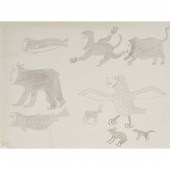 Samuellie Tunnillie (b. 1918),
Samuellie Tunnillie (b. 1918), Kinngait (Cape Dorset) UNTITLED (CREATURES), CA. 1960 artist's name lower right; unframed 18 x 23.75 in — 45.7 x 60.3 cm
Samuellie Tunnillie (b. 1918),
Samuellie Tunnillie (b. 1918), Kinngait (Cape Dorset) UNTITLED (CREATURES), CA. 1960 artist's name lower right; unframed 18 x 23.75 in — 45.7 x 60.3 cm -
 Portrait of Reverand Thomas John
Portrait of Reverand Thomas John Young Minister at St. Michael's Charleston South Carolina mid 19th century encased ambrotype of portrait miniature painted circa 1840. sight size: H3 1/2'' W2 1/2'' overall: H5'' W3 3/4'' Provenance: Property descended in the prominent early Charleston South Carolina Gourdin and Young families to present owner. Henry Gourdin Young (1909 -1989 great-grandson of sitter) Joseph Rutledge Young (1880-1936 grandson of sitter) Henry Edward Young (1831-1918 son of sitter) Rev. Thomas John Young (1803-1852 the sitter) Literature: Gourdin Peter Gaillard. THE GOURDIN FAMILY. Easley SC: Southern Historical Press 1980. pp.472- 474 568-570. For detailed accounts of the Gourdin Brothers and their family in Charleston see Racine Philip N. Editor. GENTLEMEN MERCHANTS: A CHARLESTON FAMILY'S ODYSSEY 1828-1870. Knoxville: University of Tennessee Press 2008. A similar portrait of the Reverand is featured in Fant Christie Zimmerman editor et all. SOUTH CAROLINA PORTRAITS. Columbia SC: The National Society of The Colonial Dames of America in The State of South Carolina 2000 p.425. Other Notes: The Reverand Thomas John Young (1803-1852) married Rebecca Ann Gourdin daughter of Samuel Gourdin (1766-1821) in 1828. He was the minister of St. Michael's Church in Charleston from 1847-1852. His son Henry Edward Young (1831-1918) was a Charleston lawyer and a prominent member of the South Carolina bar. During the Civil War he served as a Major in the Confederate Army and also as Judge Advocate General of the Army of Northern Virginia on the staff of General Robert E. Lee.
Portrait of Reverand Thomas John
Portrait of Reverand Thomas John Young Minister at St. Michael's Charleston South Carolina mid 19th century encased ambrotype of portrait miniature painted circa 1840. sight size: H3 1/2'' W2 1/2'' overall: H5'' W3 3/4'' Provenance: Property descended in the prominent early Charleston South Carolina Gourdin and Young families to present owner. Henry Gourdin Young (1909 -1989 great-grandson of sitter) Joseph Rutledge Young (1880-1936 grandson of sitter) Henry Edward Young (1831-1918 son of sitter) Rev. Thomas John Young (1803-1852 the sitter) Literature: Gourdin Peter Gaillard. THE GOURDIN FAMILY. Easley SC: Southern Historical Press 1980. pp.472- 474 568-570. For detailed accounts of the Gourdin Brothers and their family in Charleston see Racine Philip N. Editor. GENTLEMEN MERCHANTS: A CHARLESTON FAMILY'S ODYSSEY 1828-1870. Knoxville: University of Tennessee Press 2008. A similar portrait of the Reverand is featured in Fant Christie Zimmerman editor et all. SOUTH CAROLINA PORTRAITS. Columbia SC: The National Society of The Colonial Dames of America in The State of South Carolina 2000 p.425. Other Notes: The Reverand Thomas John Young (1803-1852) married Rebecca Ann Gourdin daughter of Samuel Gourdin (1766-1821) in 1828. He was the minister of St. Michael's Church in Charleston from 1847-1852. His son Henry Edward Young (1831-1918) was a Charleston lawyer and a prominent member of the South Carolina bar. During the Civil War he served as a Major in the Confederate Army and also as Judge Advocate General of the Army of Northern Virginia on the staff of General Robert E. Lee. -
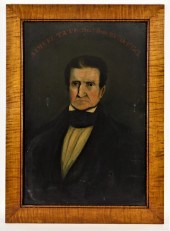 AMERICAN PRIMITIVE FOLK ART O/B
AMERICAN PRIMITIVE FOLK ART O/B PORTRAIT PAINTING United States,19th-Early 20th CenturyDepicting a dour faced Samuel Tate senior dressed in a high collared white shirt, black cravat, and black evening jacket. Mr. Tate was born October, 1763 on the ocean voyage from Londonderry, Ireland to America to parents Samuel "Rock" Tate and Elizabeth (Caldwell) Tate. He was later married to Elizabeth (Alexander) Tate and resided in Pennsylvania until his death in 1849. Housed in a tiger maple frame.
AMERICAN PRIMITIVE FOLK ART O/B
AMERICAN PRIMITIVE FOLK ART O/B PORTRAIT PAINTING United States,19th-Early 20th CenturyDepicting a dour faced Samuel Tate senior dressed in a high collared white shirt, black cravat, and black evening jacket. Mr. Tate was born October, 1763 on the ocean voyage from Londonderry, Ireland to America to parents Samuel "Rock" Tate and Elizabeth (Caldwell) Tate. He was later married to Elizabeth (Alexander) Tate and resided in Pennsylvania until his death in 1849. Housed in a tiger maple frame. -
 Samuel Bentz (Mount Pleasant Artist
Samuel Bentz (Mount Pleasant Artist Lancaster County Pennsylvania 1792-1850) ink and watercolor fraktur birth certificate for Leah... ?
Samuel Bentz (Mount Pleasant Artist
Samuel Bentz (Mount Pleasant Artist Lancaster County Pennsylvania 1792-1850) ink and watercolor fraktur birth certificate for Leah... ? -
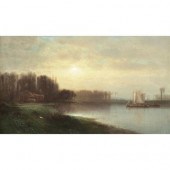 Samuel Colman American, 1832-1920
Samuel Colman American, 1832-1920 River Landscape, 1861 Estimate:$8,000-$12,000
Samuel Colman American, 1832-1920
Samuel Colman American, 1832-1920 River Landscape, 1861 Estimate:$8,000-$12,000 -
 Samuel Sartain (Pennsylvania
Samuel Sartain (Pennsylvania 1830 - 1906) engraving after a work by W.C.T. Dobson ''Bethlehem '' nativity scene with corresponding Bible verse underneath significant toning and some staining framed ss: 19'' w. x 15'' h.
Samuel Sartain (Pennsylvania
Samuel Sartain (Pennsylvania 1830 - 1906) engraving after a work by W.C.T. Dobson ''Bethlehem '' nativity scene with corresponding Bible verse underneath significant toning and some staining framed ss: 19'' w. x 15'' h. -
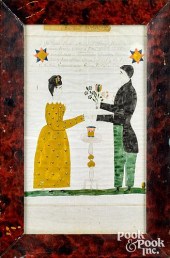 REVEREND HENRY YOUNG BIRTH
REVEREND HENRY YOUNG BIRTH CERTIFICATEReverend Henry Young (Southeastern Pennsylvania 1792-1858) , Union County ink and watercolor birth certificate for Simon Roush, b. 1801, 11 1/2" x 6 3/4". Competitive in-house shipping is available for this lot. Condition: Creases. Tape across top.
REVEREND HENRY YOUNG BIRTH
REVEREND HENRY YOUNG BIRTH CERTIFICATEReverend Henry Young (Southeastern Pennsylvania 1792-1858) , Union County ink and watercolor birth certificate for Simon Roush, b. 1801, 11 1/2" x 6 3/4". Competitive in-house shipping is available for this lot. Condition: Creases. Tape across top. -
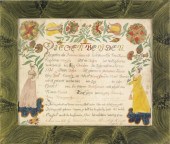 Daniel Peterman (York County
Daniel Peterman (York County Pennsylvania active 1819-1864) watercolor and ink on paper fraktur for John Singly 1826 with central... ?
Daniel Peterman (York County
Daniel Peterman (York County Pennsylvania active 1819-1864) watercolor and ink on paper fraktur for John Singly 1826 with central... ? -
 * BANNERMAN HELEN Histoire du Petit
* BANNERMAN HELEN Histoire du Petit Negre Sambo New York: Frederick A. Stokes Company 1921. Inscribed by William Baily to Norman ''The boy with a 'motive' in life.''
* BANNERMAN HELEN Histoire du Petit
* BANNERMAN HELEN Histoire du Petit Negre Sambo New York: Frederick A. Stokes Company 1921. Inscribed by William Baily to Norman ''The boy with a 'motive' in life.'' -
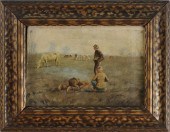 SAMUEL S. CARR (1837-1908): KEEPING
SAMUEL S. CARR (1837-1908): KEEPING WARM IN THE FIELDS Oil on canvas signed lower right. 10 x 14 in. (sight) 15 1/2 x 20 in. (frame).
SAMUEL S. CARR (1837-1908): KEEPING
SAMUEL S. CARR (1837-1908): KEEPING WARM IN THE FIELDS Oil on canvas signed lower right. 10 x 14 in. (sight) 15 1/2 x 20 in. (frame). -
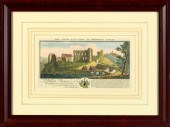 Samuel and Nathaniel Buck (British,
Samuel and Nathaniel Buck (British, 18th Century) "Castles and Castle Ruins", suite of four hand-colored engravings, sight 12-1/2" x 19-1/2", legend in lower margins. Glazed, matted and presented in stained mahogany frames.
Samuel and Nathaniel Buck (British,
Samuel and Nathaniel Buck (British, 18th Century) "Castles and Castle Ruins", suite of four hand-colored engravings, sight 12-1/2" x 19-1/2", legend in lower margins. Glazed, matted and presented in stained mahogany frames. -
 Samuel and Nathaniel Buck
Samuel and Nathaniel Buck (1696-1779 and fl. early/mid 18th Century) - Coloured engraving - ''The South-West Prospect of the City of Canterbury'' 12ins x 31.5ins published 1738 in Hogarth frame and glazed
Samuel and Nathaniel Buck
Samuel and Nathaniel Buck (1696-1779 and fl. early/mid 18th Century) - Coloured engraving - ''The South-West Prospect of the City of Canterbury'' 12ins x 31.5ins published 1738 in Hogarth frame and glazed -
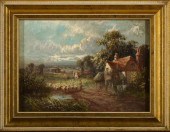 Sydney Yates Johnson (British,
Sydney Yates Johnson (British, 19th/20th Century) "A Shepherd and His Flock in a Highland Landscape", oil on canvas, 10" x 14", signed lower right "S. Y. Johnson". Presented in a contemporary giltwood frame.
Sydney Yates Johnson (British,
Sydney Yates Johnson (British, 19th/20th Century) "A Shepherd and His Flock in a Highland Landscape", oil on canvas, 10" x 14", signed lower right "S. Y. Johnson". Presented in a contemporary giltwood frame. -
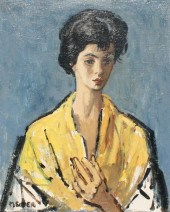 SOYER Moses (American 1899-1974):
SOYER Moses (American 1899-1974): ''Girl in the Yellow Shawl'' OIL/Canvas 21'' x 17'' signed framed 26'' x 22''.
SOYER Moses (American 1899-1974):
SOYER Moses (American 1899-1974): ''Girl in the Yellow Shawl'' OIL/Canvas 21'' x 17'' signed framed 26'' x 22''. -
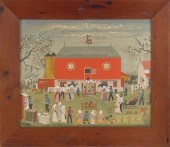 David Y. Ellinger (American
David Y. Ellinger (American 1913-2003) silkscreen of an Amish auction 22" x 27". ?
David Y. Ellinger (American
David Y. Ellinger (American 1913-2003) silkscreen of an Amish auction 22" x 27". ?
...many more examples with full details are available to our members - Learn more
